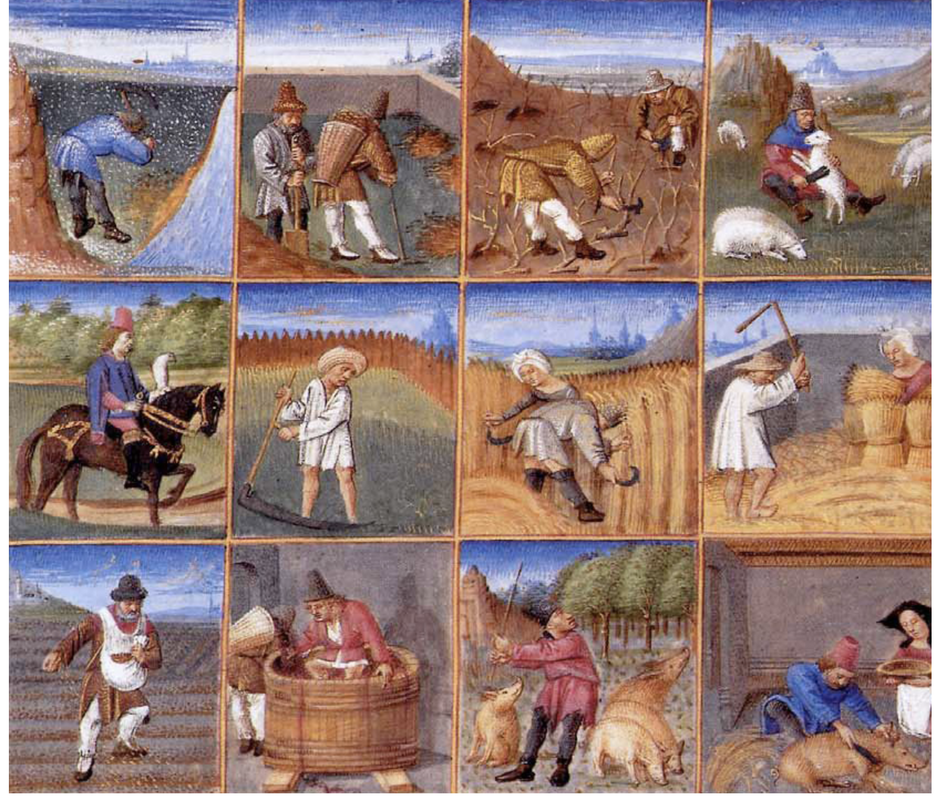Week Six: Time and Seasons
oCentral to HIldegard was the integration of the concepts of Benedictine balance and Celtic seasons.
As a Benedictine, Hildegard would have alternated feasting and fasting. Indeed, she has left us rather detailed instructions for three kinds of fasting, with recommendations for diet for each season. See this link for detailed instructions from Hildegard.
Feast days were associated with either a liturgical celebration ( such as Christmas, Pentecost, Easter) or the feast day of a particular saint. By far the most popular saint in the MIddle Ages was the Virgin Mary- there were separate feast days for her nativity, presentation, conception, the Annunciation and more. There were mandated Major feast days by the Catholic Church in which all laborers must be released from their work to attend special services; for monks and nuns, feast days meant musical variety, rituals recounting the lives of the saints and additional wine and dessert. Some of the saints were universally celebrated throughout Medieval Christendom (Like John the Baptist on June 24 and Mary Magdalene on July 22), other saints only had "local" or "regional" saints. Hildegard wrote special music, for example, for the Feastdays of St. Disibod and St.Ursula who were deeply venerated in her local community.
As a Benedictine, Hildegard would have alternated feasting and fasting. Indeed, she has left us rather detailed instructions for three kinds of fasting, with recommendations for diet for each season. See this link for detailed instructions from Hildegard.
Feast days were associated with either a liturgical celebration ( such as Christmas, Pentecost, Easter) or the feast day of a particular saint. By far the most popular saint in the MIddle Ages was the Virgin Mary- there were separate feast days for her nativity, presentation, conception, the Annunciation and more. There were mandated Major feast days by the Catholic Church in which all laborers must be released from their work to attend special services; for monks and nuns, feast days meant musical variety, rituals recounting the lives of the saints and additional wine and dessert. Some of the saints were universally celebrated throughout Medieval Christendom (Like John the Baptist on June 24 and Mary Magdalene on July 22), other saints only had "local" or "regional" saints. Hildegard wrote special music, for example, for the Feastdays of St. Disibod and St.Ursula who were deeply venerated in her local community.
In our modern world, we have lost the rhythm of nature. We eat food from halfway across the world and import flowers from other countries at great environmental cost. Hildegard understood the importance of living in balance with the elements and the seasons, and would have honored them all.
The following recipe has been adapted from Hildegard's 12th century volume Physica: Liber Simplicis Medicina ) Hildegard of Bingen believed that these spice biscuits should be taken t regular intervals to increase joy and health.
HIldegard's Blessing Biscuits ( also known as Cookies of Joy)
Minutes to Prepare: 10
Minutes to Cook: 15
Ingredients
Directions: Cream together softened butter with the brown sugar. Beat in the egg. Sift the dry ingredients. Add half the dry ingredients and mix. Add the other half and mix thoroughly. Heat oven to 350°. Form small balls of dough, place on greased and floured cookie sheet and press flat. Bake 12-15 minutes (till edges of are golden brown.)
Cool for 5 minutes, remove from cookie sheet and finish cooling on racks.
HIldegard's Blessing Biscuits ( also known as Cookies of Joy)
Minutes to Prepare: 10
Minutes to Cook: 15
Ingredients
- 3/4 cup butter (1 1/2 sticks)
1 cup brown sugar
1 egg
1 tsp baking powder
1/4 tsp salt
3/4 cup plain flour - 3/4 cup spelt flour
1 tsp ground cinnamon
1 tsp ground nutmeg
1/2 tsp ground cloves - pinch ginger
Directions: Cream together softened butter with the brown sugar. Beat in the egg. Sift the dry ingredients. Add half the dry ingredients and mix. Add the other half and mix thoroughly. Heat oven to 350°. Form small balls of dough, place on greased and floured cookie sheet and press flat. Bake 12-15 minutes (till edges of are golden brown.)
Cool for 5 minutes, remove from cookie sheet and finish cooling on racks.
Whom would you include in your own personal "Feast Day Calendar of Saints"? Mine has not only religious figures like St. Francis, ( October 4), Mary Magdalene ( July 22), HIldegard of Bingen (September 17) and Julian of Norwich (May 8), but also cultural figures like Bach (March 31), Beethoven (December 16), Erik Satie (May 17). I have hosted public "saint days" concerts for Mozart and Schubert , sharing the stories of their lives interwoven with live performances of their music, but you could do the same thing at home: put their names on Spotify and then watch a documentary about these fascinating figures. Gather friends together to toast Mary Oliver ( September 10) and take turns reading her poems.
For your own personal ancestors, watch their favorite movie, play their favorite music, make their favorite meal and share the stories of their lives that you remember with your family. If you want to honor ancestors the way the Celtic Christians did, you would even set a place for them at the table- and you could include an object that once belonged to them, or, to be more modern, a picture of them in the prime of their wisdom.
For your own personal ancestors, watch their favorite movie, play their favorite music, make their favorite meal and share the stories of their lives that you remember with your family. If you want to honor ancestors the way the Celtic Christians did, you would even set a place for them at the table- and you could include an object that once belonged to them, or, to be more modern, a picture of them in the prime of their wisdom.
Contact Kayleen Asbo: [email protected]

